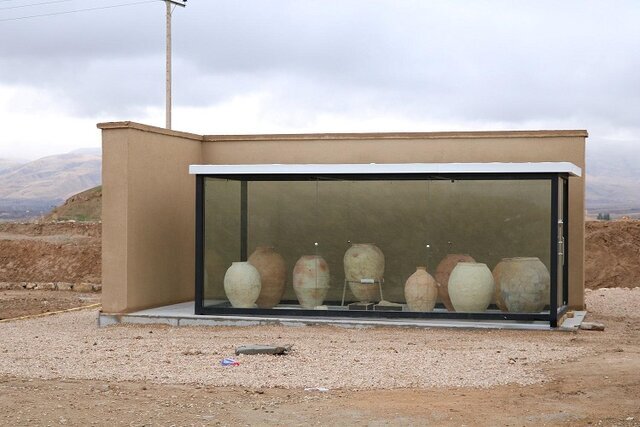Tepe Rivi: display case constructed to showcase unearthed relics

TEHRAN – A newly-constructed display case has put on view relics, mostly giant urns, discovered from the Tepe Rivi, a millennia-old archaeological hill in northeast Iran.
“We started displaying a number of relics discovered from Tepe Rivi at a display case embedded at the archaeological site,” the director of Rivi site said on Tuesday.
The class case showcases restored objects including pots, clays, bricks, stone mortars, etc. that date back to the Achaemenid, Parthian, and Sassanid eras, he said.
In an interview with ISNA, Mohammad Javad Jafari stated that ten archaeological seasons have taken place on the ancient site so far.
“Every year, since the beginning of archaeological excavations here, we managed to unearth a considerable number of relics, few of which are intact and many are broken and incomplete,” Jafari said.
After carrying out archeological studies, these objects will ultimately be transferred to the Bojnord Museum for preliminary protection and restoration, the expert said.
Earlier in November, ruins of a prehistorical fortress, estimated to date some 2,700 years, were found near the ancient hill.
According to experts, the fortress once belonged to Medes, ancient Iranian people who inhabited an area known as Media between western and northern Iran, adding that evidence concerning residents of the 900 century BC has come to light as well.
In 2019, a joint mission of Iranian and German archaeologists discovered historical clay stamps in the Rivi region, which are estimated to date from the Achaemenid and Parthian eras. The seals were found alongside clay urns in a large hall, and the seals are imprinted in a variety of geometric patterns [depicting] plants, animals, and human figures.
Evidence suggests that residents of this area sealed the urns that were loaded with particular goods and then tied them with ropes, the archaeologist said. In May 2021, the restoration of some ruined structures, particularly those dating from the Achaemenid era, started. Moreover, a team of restorers began work last December on earthenware and other relics discovered from the site.
AFM
Leave a Comment